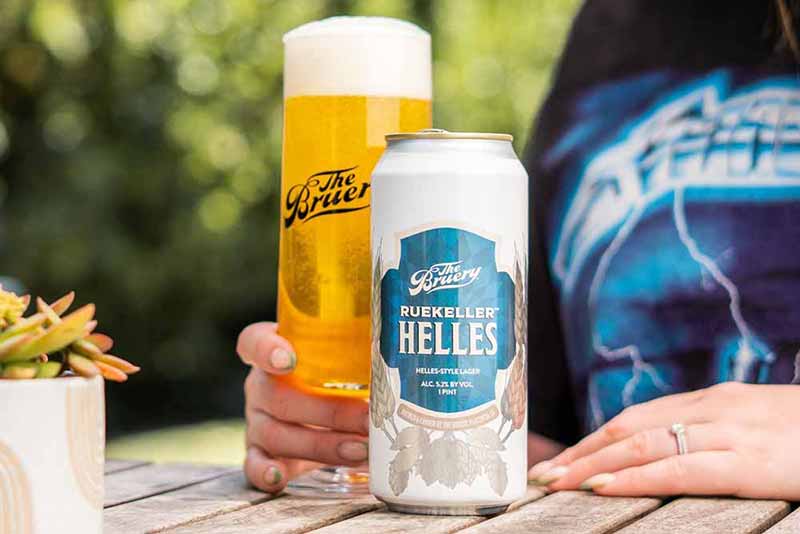
With more than nine thousand craft breweries across the United States, there is plenty of creativity in brewing. From hazy IPAs to SMaSH beers and smoothie sours, you name it, a brewery has done it.
And while these beers are wildly popular, sometimes a consumer bellies up to a bar just hoping to get an old-school beer like a helles lager.
The classic beer takes on a bright, yellow, pale look—the definition of the German word “helles”—with a thick white head, while the hops, malts, and yeast expertly balance for a crisp, clean finish.
While a helles lager may seem simple, brewing this style can be challenging.
We talked to five breweries across the U.S. known for their top-rated helles lagers to discover the best practices for brewing a helles lager.
Keep reading to see what brewers at The Bruery, Wondrous, Human Robot, Faction, and pFriem Family Brewers shared.
(Photography courtesy of The Bruery)
What We’ll Cover in This Piece:
Affordable, Industry-Leading Brewery Software
How to Build a Recipe for a Helles Lager
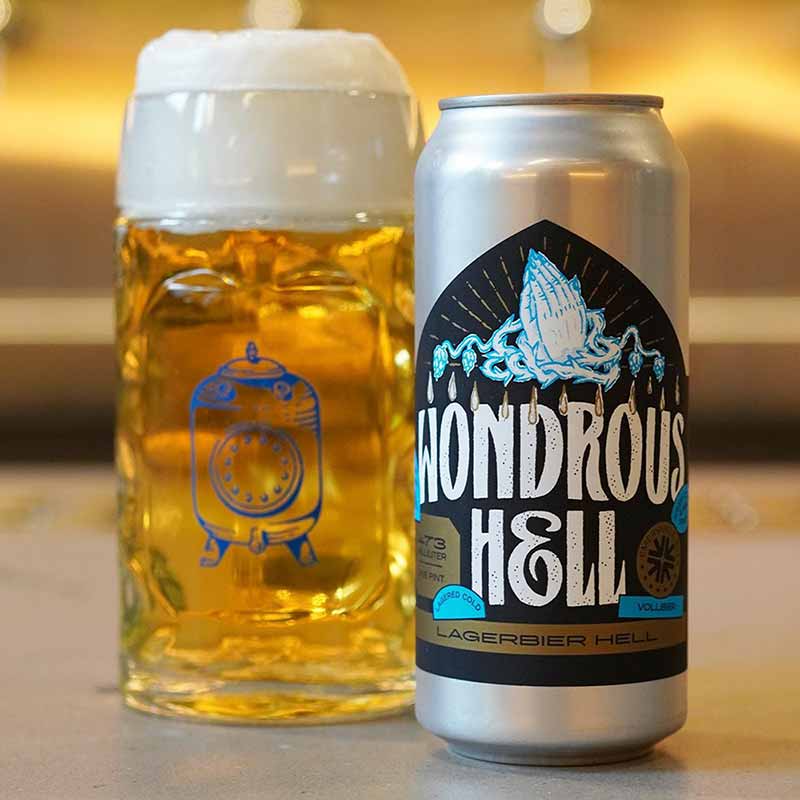
Photography courtesy of @wondrousbrewing
Because this beer can’t hide behind adjuncts and other flavor profiles, pFriem Family Brewers Co-Founder and Brewmaster Josh Pfriem says you must thread a needle between complexity and drinkability.
“You have to have great malt, and all you need is multiple different types of Pilsner malt,” Pfriem says in an email. “Hops should be floral and earthy, just enough there to balance the sweetness of the malt. Acidity and sulfur levels need to be on point and present.”
Rodger Davis, owner and head brewer at Faction, seconds Pfriem.
“It’s not the hops, it’s the malt,” Davis says.
Because helles is not a heavy-drinking beer, Human Robot Head Brewer Andrew Foss also goes for a bready malt character without too many hops.
In addition to using a malt-forward approach, helles are lagers at the end of the day. When brewing this style, you’re looking for a crisp profile.
The Bruery Brewing and Cellar Manager Justin Radel says the more important part of the helles lager is that it is clean and lagers for the appropriate amount of time.
“You want the helles lager to be really bright, crystal clear, and slightly malty like a little bit of a bready, crackery taste with just a little bit of a noble hop bitterness,” Radel says.
At Wondrous, Owner and Head Brewer Wynn Whisenhunt says their Wondrous Hell is the only beer they have on tap 365 days a year. One of his favorites, Wisenhunt looks for a helles to be a crisp, pale German lager.
“It’s all about super clean healthy fermentation, a really beautiful balance of malts, water character, a little dash of hops in there to balance malt sweetness,” Whisenhunt says. “It’s super well-balanced. It’s one of the most drinkable beers in existence.”
How Important Is Water in Your Helles Lager Recipe?

Photography courtesy of @factionbrewing
It may be redundant because water is essential in all beer. However, with helles lagers following the German Purity Law, Reinheitsgabot, water is paramount.
Pfriem says he finds that locking in a pH in the mid-fours works well for their pFriem Lager, their helles beer without the name.
“Hard to make a good helles without good water and focus on water chemistry—4.45-4.5 pH works very well,” he says.
Davis notes that Faction aims for a pH in the low fives for their helles lager.
“We knock out around 5.2 to 5.3,” he says. “We strive for that in the mash.”
While for most of what they brew at Human Robot, they don’t stress about the pH, their helles is different. Foss says that with their decoction boil having all the grains in there, you can pull some astringencies out of the husks if your pH is high to meet specs or desired levels.
“Most of our beers we spec between 5.2 and 5.4, and we don’t make a big deal out of it,” Foss says. “This beer has to be down between 5.0 to 5.2 before you boil it.”
Foss adds that early in the mash, they let it stay high in the 5.6 area for enzyme activity, and once they boil, they bring it down below 5.2 pH.
Radel says water chemistry is pretty crucial for helles beers, for sure.
“We try a pH of 5.2, 5.3 for the mash,” Radel says. “And for the [supplemental] addition, we try our best to match Munich’s water profile.”
For Whisenhunt’s helles at Wondrous, they shoot for a 5.2 but are OK with anything from 5.1 to 5.4 pH. For a helles, the slightest variance in the pH could make a considerable change.
“I think [pH] is just as important in a helles as any other beer out there,” Whisenhunt says. “A difference of .1 or .2 could be a big flavor, mouthfeel difference. pH is super important.”
The Best Malts and How to Use Them in a Helles Lager
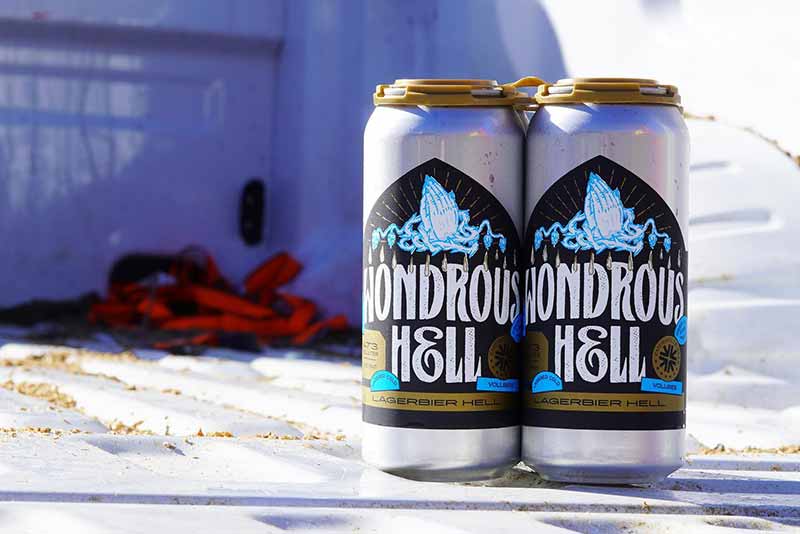
Photography courtesy of @wondrousbrewing
According to the five brewers who spoke to us for this piece, it’s all about pilsner malts.
pFriem uses a blend of Weyermann Pilsner Malt, Gambrinus Pilsner Malt, and Canada Malting Superior Pilsen Malt.
Davis says that Faction opts for Weyermann malts to get a balance of biscuity taste. And when they have it, he says they use Weyermann’s Premium Pilsner “because it has a nutty, biscuity overtone to it,” that is ideal for a helles lager.
Davis adds that they also throw in carapils or carafoam, as well as dextrin for body and acidulated malts for pH control, and mash it at 154 degrees Fahrenheit.
Human Robot differs from other breweries since they follow the Schmidt’s process of brewing—a single-pot decoction that includes all the malts, hops, and water—for its helles. But they use similar malts with a subtle twist.
“We use all pale malts, German pilsner malt with ten or twenty percent Vienna,” Foss says.
At The Bruery, Radel says they use a single-infusion mash featuring mostly pilsner malts, as well as about one percent of melanoidin and a few dextrin malts for head retention.
“I can’t do any step mashes or decoction mashes,” Radel says. “It’s a pretty basic grist … ninety-five percent pilsner malt.”
Whisenhunt takes it one step further at Wondrous.
“Super simple. All pilsner malt,” he says. “We try to use the most pale German pilsner malt we can find. With helles, the beer is a reflection of what ingredients you use. We found a super paler-than-pilsner malt, pilsner malt, and that’s the base for our [Wondrous Hell].”
How to Use Yeast in a Helles Lager
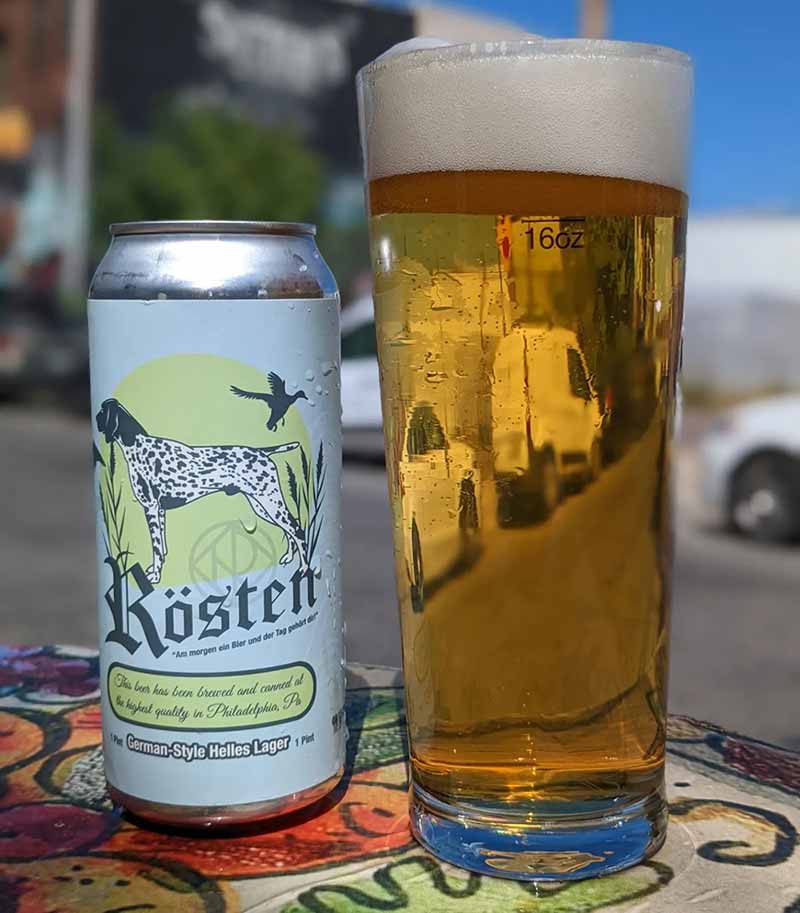
Photography courtesy of @humanrobotbeer
A great helles needs a healthy yeast pitch.
As for what yeast, most breweries use their own house strain. pFriem uses Weihenstephan 3470 for its helles lager.
At Faction, they don’t have a way to do cell counts, so Davis says they use brewer’s intuition when they pitch their yeast, German-based Andechs.
“When you think you have enough, add a little more,” Davis says. “Give it a big, healthy pitch.”
Like pFriem, Foss says at Human Robot they use the Weihenstephan 3470 for their helles beer and all their lagers.
“It’s a good workhorse lager strain,” he says. “It responds very differently to different top pressure and temperature during fermentation.”
Yeast fermentation is pivotal, Whisenhunt says. Wondrous uses a house lager strain for its helles lager.
“If you’re using some old, stinky yeast, it’s going to show in the beer,” he says. “Maybe try a yeast starter, or try and have a nice, healthy fresh pitch of yeast; it will go miles for the quality of the beer.”
Similarly, The Bruery uses a house strain for its helles.
“We call it Global … it’s nothing really special,” says Radel. “It’s just a standard lager yeast strain.”
A Quick Word on Hops in a Helles Lager

Photography courtesy of @factionbrewing
A helles doesn’t feature a strong hop element, so IBUs should be relatively low.
For Pfriem, he uses Perle and Tettnang hops early in the boil and then throws in some more Tettnang towards the latter part, resulting in around 20 IBUs.
Davis says that Faction mixes it up with the hops in their traditional helles beer, but they always keep it to German hops. Think Saaz, Hallertau, Mittlefruh, and Saphir, among others. Faction uses one pound per barrel, if that, according to Davis.
“It’s so lightly hopped, I would be very surprised if anyone could notice,” Davis says.
Foss says they throw in Tettnang during the decoction boil, leaving minimal bitterness.
“The philosophy of [putting the hops in] that way is that when you boil hops in a higher gravity solution, there’s a lot less bitterness extraction, and you get a really rounded bitterness profile,” Foss says. “Basically, you’re just trying to boil them in a concentrated wort before diluting them.”
Radel notes that their Ruekeller Helles falls at or below 20 IBUs, and they use German Magnum hops, which they throw in for sixty minutes and then again with ten minutes left in the boil.
Wondrous does a sixty-minute hop addition to generate 20 IBUs for its helles lager, Whisenhunt said. In total, Whisenhunt says they run a ninety-minute boil for their Wondrous Hell.
Five Examples of Successful Helles Lagers
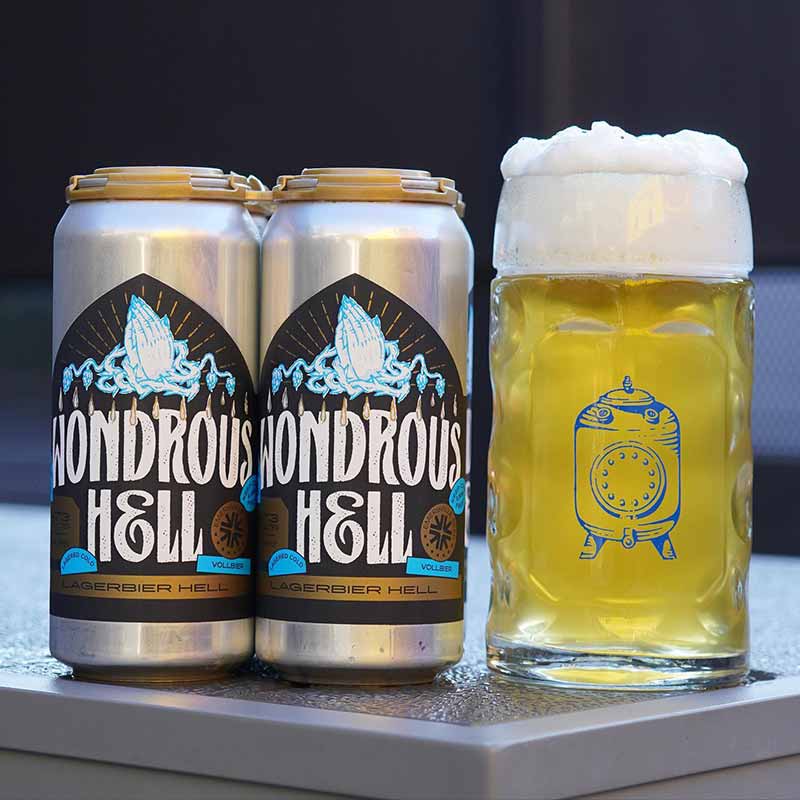
Photography courtesy of @wondrousbrewing
The pFriem Family Brewers’ helles launched recently, introduced this past winter, though they have been working on tweaks to the recipe for a decade, Pfriem says.
The pFriem Lager is 5% ABV with notes of honeydew and fresh bread. It is now available year round and sold in six-packs of twelve-ounce cans.
According to Davis, Faction has a traditional helles lager and a bastardization of a helles that uses U.S. hops from the Pacific Northwest. Helles Lager is 5.1% ABV using German hops, which deliver 23 IBUs. The Hella Strata is a helles-style lager using Strata hops and is 4.7% ABV with 25 IBUs.
Human Robot’s Rösten helles lager is a 4.8% ABV pale-colored beer crafted with the medieval single-pot method—simultaneously putting in all the hot-side ingredients.
Wondrous’ Wondrous Hell, an unfiltered house lagerbier, clocks in at 5.1% ABV, hits 18 IBUs, and features all the qualities of a helles beer to a T.
The Bruery has crafted a highly rated helles of their own, Ruekeller: Helles. The crisp, malty brew is 5.2% ABV, crafted through the inspiration of old-world brewing techniques.
One Extra Tip for Brewing a Helles Lager

Photography courtesy of The Bruery
Use fresh ingredients. That’s the name of the game with helles beer.
“This is a naked beer with nothing to hide behind. You cannot cut corners and expect to make something that is nuanced yet so flavorful and drinkable,” Pfriem says. “If you use good Pilsner malt and have good mashing procedures, you will get great malt character without making a sweet, clunky beer.”
Foss says that a helles is a super simple beer, so ingredients are paramount.
“Just making sure you have really good, quality ingredients is number one,” he says. “If you’re not a super experienced lager brewer, you want to make sure you have a good second- or third-generation large pitch of yeast that is active.”
Radel and all the brewers interviewed for this piece emphasized that the beer needs time to ferment. But making a great helles comes down to simple things.
“It boils down to ingredient selection, a healthy yeast pitch, and just giving the beer enough time,” he says. “It’s really simple. It’s malt, water, hops, yeast … It’s about paying attention [to the process].”
Whisenhunt, who studied how to brew beer in Munich, concurred with all the other brewers here.
“It’s a very, very simple beer, to be honest,” he says. “As long as you’re using fresh malt and very healthy yeast, and you’re fermenting it in a lovely manner, it’s going to be a great beer.”
Foss adds one more nugget for anyone looking to excel in brews such as helles lagers.
“If you have a way to get in touch with someone and pick their brain a little bit, it will help you develop your style through your own lens,” he says. “It’s always helpful to get different perspectives even if you don’t deploy them at all.”



